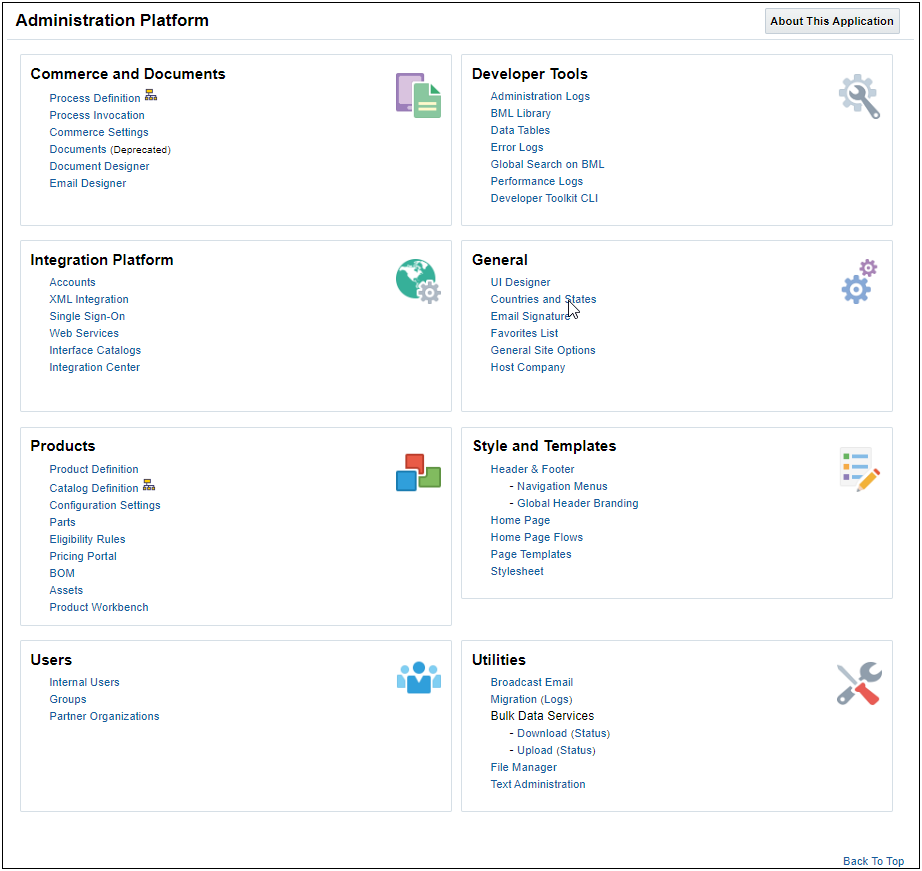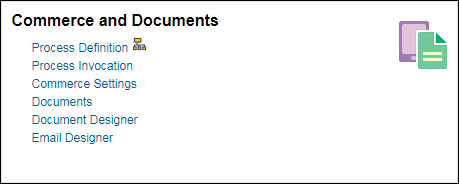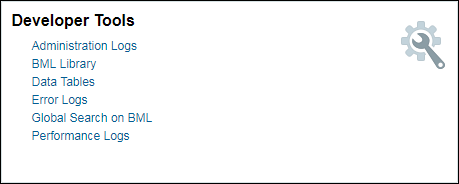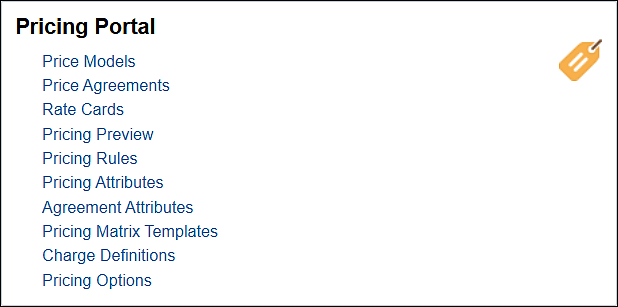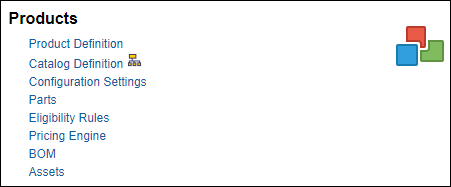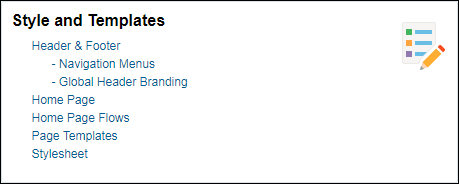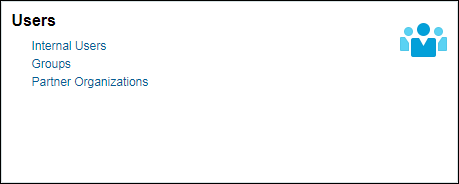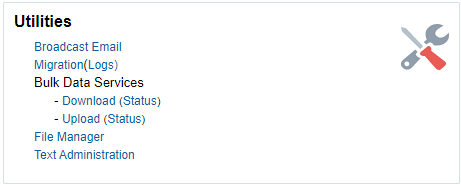Overview
The Oracle CPQ Administration Home Page, referred to as the Admin Home Page, is a frequently used destination for Oracle CPQ admins. Each link on the Admin Home Page is the gateway to a different administration module. Either directly, or through a navigation path that originates on the Admin Home Page, every admin page in Oracle CPQ can be accessed from the Admin Home Page.
In the screenshot below, click on any of the eight sections to go directly to information about that section.
Administration
To access the Admin Home Page, click the Admin button. Your site implementation may have customized the look of this button (typically near the top-right corner of the page), but it usually looks like one of the following images:
 or
or 
After clicking the button, the Administration Platform page opens; this is the Admin Home Page.
- Process Definition: For a Commerce Process, define things like documents, attributes, actions, and Steps. For more information, refer to Commerce Process Overview.
- Process Invocation: Define rules that enable the user to invoke a Commerce Process from pages in the application, such as Configuration and Parts pages. For more information, refer to Commerce Process Overview.
- Commerce Settings: Define options for Commerce, including settings that allow Commerce Processes to be cloned and migrated. For more information, refer to Commerce Process Settings.
- Documents: Create and manage document templates with the Document Engine. For more information, refer to Document Engine Overview.
- Document Designer: Create and manage document templates with the Document Designer's drag and drop interface. For more information, refer to Document Designer Overview.
- Email Designer: Create and manage Email Templates for approval notifications or Transition Rule notifications using a drag and drop editor. For more information, refer to Email Templates Overview.
- Administration Logs: Displays log messages for admin changes done to Configuration and Commerce. Each log includes the username, Product Family, and date/time of the change. For more information, refer to Administration Logs.
- BML Library: Create BML Util library functions to be used in BML functions in Configuration and Commerce. For more information, refer to Library Functions.
- Data Tables: Create, upload, and modify Data Tables that can be queried by rules and functions throughout the system. For more information, refer to Data Table Overview.
- Error Logs: View error logs generated by Oracle CPQ for use in debugging.
- Global Search on BML: Locate BML functions using a global search of all functions on the site.
- Performance Logs: Monitor and analyze the performance experienced by Oracle CPQ sales users, refer to Performance Logs.
- Developer Toolkit CLI: Manage CPQ technical artifacts using the CPQ Developer Toolkit. This toolkit is a combination of Command Line Interface (CLI) and open REST APIs that allow customers to communicate with their CPQ site. For more information, refer to Developer Toolkit.
- Performance Reviewer: Helps identify site customizations that could contribute to performance issues. Reports check for common performance-impacting issues in BML scripts, data tables, and pricing settings. For more information, refer to Performance Reviewer.
- Implementation Report: The implementation report provides detailed insights into the customizations made in the Commerce and quoting processes. This enables administrators to rationalize the artifacts, optimize the Commerce process, and remove or refine unnecessary elements. For more information, refer to Implementation Report.
- UI Designer: Edit Oracle Application Development Framework (ADF) pages within Oracle CPQ using a drag−and−drop editor, see topic UI Designer.
- Countries and States: Define states and countries options for the site, including users and Accounts. For more information, refer to Country & State Details.
- Email Signature: Define an email signature for any email being sent from within the application. For more information, refer to Email Signatures.
- Favorites List: Manage the updating of users' Favorites to keep them in sync with current product and pricing data. For more information, refer to Favorites List.
- General Site Options: Define general application settings, including password options, login options, and settings for exchange rates and unit conversions. For more information, refer to Managing General Options.
- Host Company: Manage your company information, including supported currencies and languages. For more information, refer to Host Company.
- Lookups: Provide a single place for defining the domains of values for menu-type attributes. For more information, refer to Lookups.
- Accounts: Create, edit, and delete Accounts information (for customers using CPQ's Accounts functionality in place of a CRM system). For more information, refer to Accounts.
- XML Integration: Define communication parameters for XML Integration though middleware to a backend ERP system. For more information, refer to XML Integration.
- Single Sign-On: Manage authentication to allow users to automatically log into Oracle CPQ without the need for multiple logins and re-authentication. For more information, refer to Single Sign-On (SSO).
- Web Services: Test SOAP APIs by generating and modifying inputs and endpoints and sending test SOAP calls in order to integrate with on-demand web applications. For more information, see the topics Web Services 1.0 or Web Services 2.0.
- Interface Catalogs: Discover and use the SOAP and REST Web Services available for all services supported by CPQ. For more information, refer to Interface Catalog.
- Integration Center: Use the Integration Center to for managing integrations with CPQ, such as DocuSign eSignature, OAuth Provider, and Customer Relationship Management (CRM). For more information, refer to Integration Guide.
-
Price Models: very simply are containers for prices. They contain a set of price points, a set of discounts, or a set of markups that can be applied based simple conditions or complex conditions. For more information, refer to Price Models.
-
Price Agreements: allow customers to specify agreement pricing within CPQ. A sales agreement refers to a formal contract or arrangement between a seller and a customer that outlines the terms, conditions, pricing, and other details related to the products or services being sold. For more information, refer to Price Agreements.
-
Rate Cards: can be used to support subscription-based pricing for industries such as communications, utilities, and cloud services. Rate Cards and their associated templates can be used to define complex usage-based pricing. For more information, refer to Rate Cards.
-
Pricing Preview: allows pricing administrators and product managers to validate pricing during or after setup. Administrators can view a price waterfall visualization or tabular data to display various pricing factors for a product (e.g. base price, discounts, promotions, and manual adjustments). For more information, refer to Pricing Preview.
-
Pricing Rules: can be used to specify simple and complex conditions to determine when the Pricing Engine will invoke pricing from linked price models. For more information, refer to Pricing Rules.
-
Pricing Attributes: are mapped to specific attributes from Commerce, Parts, or Configuration. CPQ provides several standard Pricing Attributes with predefined mapping for frequently used attributes and customers can also add their own custom Pricing and Charge Attributes. For more information, refer to Pricing Attributes.
-
Agreement Attributes: support attributes that are used to create a Price Agreement from a sales agreement-type transaction. They provide the necessary mapping for Commerce attributes to the corresponding pricing attributes for Price Agreements. For more information, refer to Agreement Attributes.
-
Pricing Matrix Templates: support pricing that requires the Pricing Engine to use a custom dynamic matrix as the basis for calculating runtime prices. Pricing Matrix Templates can be used to price both one-time or recurring product prices and charges. For more information, refer to Pricing Matrix Templates.
-
Charge Definitions: can be used to standardize charge categories. (e.g. Activation Fee, Call Usage, Data Usage, One-time Pricing, Recurring Pricing) and to define the valid combinations of price types and charge types .For more information, refer to Charge Definitions.
-
Pricing Options: are used to administer pricing-related settings. For more information, refer to Pricing Options.
- Product Definition: Create Product Families for Configuration and define products; for example, define meta data definitions for your catalog items. For more information, refer to Setting Up Product Families.
- Catalog Definition: Create the product hierarchy of Product Families by creating Product Lines and Models. Create attributes, rules, Configuration Flows, and more to build Configurators to assist sales users in configuring products. For more information, refer to Setting Up Product Families.
- Configuration Settings: Define Configuration settings, including recommended items and configurable pricing options. For more information, refer to Configuration Overview.
-
Parts: Define parts data, including part numbers, serial numbers, and part custom fields. For more information, refer to Parts - An Overview.
- Eligibility Rules: Eligibility Rules allow administrators to define the parts available to specific customers. For more information, refer to Eligibility Rules
- BOM: Access BOM functions and objects to set up and maintain BOM Mapping Implementations. For more information, refer to BOM Mapping Overview.
- Assets: Access the Customer Assets page to view purchased, modified, and terminated assets; and to search, filter, and sort assets. For more information, refer to Asset-Based Ordering.
- Product Workbench: The Product Workbench is designed for product managers, with the goal of making the definition and management of their products and services more intuitive and seamless. For more information, refer to Product Workbench.
- Intelligence Portal: the Intelligence Portal enables the administration of AI generated product recommendations. For more information, refer to Intelligence Portal.
- Header & Footer: Define a custom header and footer for the site. For example, add your company logo to the header. For more information, refer to Header & Footer.
- Navigation Menus: Define the links available in the navigation bars of all user types on the site. For more information, refer to Navigation Menus
- Global Header Branding: After enabling Alta Navigation, administrators can customize the Global Header, enter a site title, and applying stylistic changes. Define the links available in the navigation bars of all user types on the site. For more information, refer to Global Header Branding
- Home Page: Define and deploy your application's Home Page. For more information, refer to Home Page.
- Home Page Flows: Define Home Page Flows to guide sales users to other user-side pages from the Home Page (for customers that are not using the standard Home Page). For more information, refer to Home Page Flows.
- Page Templates: Define templates for different pages on the site. For example, modify the Recommended Parts section of the Model Configuration page. For more information, refer to Page Templates.
- Stylesheet: Brand the site through the main application CSS stylesheet, or upload a custom stylesheet. For more information, refer to Stylesheet Manager and Partner, User, and Admin CSS Files.
- Internal Users: Create, modify, activate, or inactive internal users. For more information, refer to Setting Up Users.
- Groups: Create and manage groups of users. For more information, refer to Setting Up Groups.
- Partner Organizations: Create Partner Organizations that can use Oracle CPQ to configure and purchase your company's products. Manage a Partner Organizations' access rights and users from within each Partner Organization. For more information, refer to Partner Organizations.
- Broadcast Email: Create and send an email blast to active Host Company and/or Partner users. For more information, refer to Broadcast Email.
- Migration: Manage migrations of admin components between Oracle CPQ sites. For more information, refer to Migration Management Overview.
- (Logs): Review the status of migrations and create Snapshots that the site can revert to, if needed. For more information, refer to Rollbacks & Snapshots.
- Bulk Data Services: Upload and/or Download system data such as parts, models, Configuration rules, Data Tables, and more. For more information, refer to Bulk Uploads and Bulk Downloads.
- Download: Perform a bulk download of system data.
- (Status): View the status of bulk downloads and retrieve bulk downloaded files.
- Upload: Perform a bulk upload of system data.
- (Status): View the status and upload logs of bulk uploads.
- Download: Perform a bulk download of system data.
- File Manager: Upload and store files and images for use throughout the application. For more information, refer to File Manager.
- Text Administration: Define custom terms/wording for strings throughout the site. For example, you might want to change the "#" symbol to say "No." for "number". For more information, refer to Text Administration.
